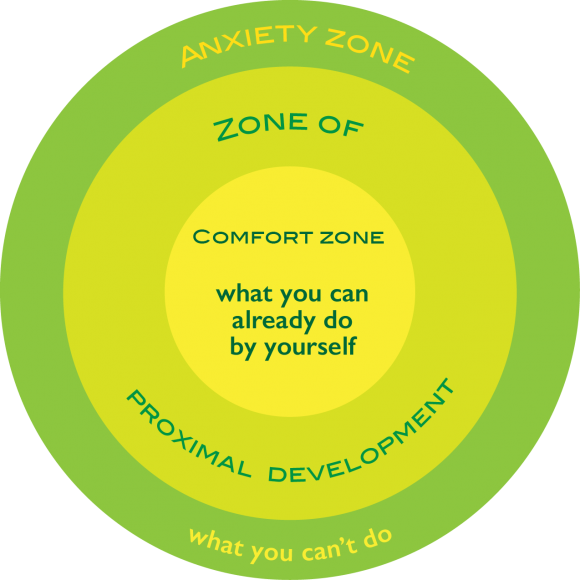The question I am often faced with is how to encourage faculty to integrate technology into their teaching. There are various reasons why people can be resistant or hesitant to adopt new technologies: previous negative experience, lower technical skills, or lack of time. One of the common reasons is lower self-efficacy when it comes to technology, when people believe that the task is too difficult for them to successfully master, and they are afraid of failure. How do we help our faculty achieve their technology goals and feel confident about their ability to do so?
 One way to approach this is from socio-cultural theory. According to Vygotsky’s zones of proximal development theory, for every learner there are tasks that he or she can do on their own, goals they can reach with the help of others, and tasks they can’t accomplish at their current level of knowledge and skills regardless of the amount of support they receive. Eventually, the learner will be able to complete on their own the tasks that he or she could previously accomplish only with others’ assistance, and previously unattainable tasks become zones of proximal development.
One way to approach this is from socio-cultural theory. According to Vygotsky’s zones of proximal development theory, for every learner there are tasks that he or she can do on their own, goals they can reach with the help of others, and tasks they can’t accomplish at their current level of knowledge and skills regardless of the amount of support they receive. Eventually, the learner will be able to complete on their own the tasks that he or she could previously accomplish only with others’ assistance, and previously unattainable tasks become zones of proximal development.
What it means for us as educators (trainers, facilitators) is that learners should be presented with the tasks they can accomplish with the help of others for learning to be both meaningful and successful. What it means for us when we help faculty develop their courses into a hybrid or an online format is that we should encourage them to use the skills they already have and suggest several new tasks that we or their peers can provide help for. The keys here are to tap into the skill-set the instructors already have and are comfortable with and then encourage them to try new activities in a safe, collaborative environment. Suggesting tasks that are outside their zone of proximal development will likely cause anxiety, and might thwart faculty from trying these tasks again in the future.
For example, for someone who wants to have online discussions in their class, but has never used discussion forums before, I would suggest starting with a basic Blackboard discussion board, since it provides a clear structure and is fairly easy to follow. Doing that will provide foundations and understanding how an online discussion works, and what the advantages and disadvantages are. With time, once the instructor feels comfortable managing a Blackboard discussion board, that may be the time to venture out and try a different tool, such as a WordPress blog, VoiceThread, or Piazza. Then we can work with a less structured environment and utilize more advanced capabilities that these tools offer, such as audio, video, or online collaboration.
This is a simplified situation and may look like an obvious solution, but the main point is that this approach helps gradually build someone’s skills starting at a fairly basic level and continuing to the point where they can work with an advanced technology tool on their own, rather then always need an instructional technologist by their side.


